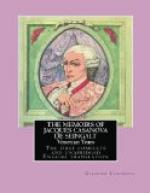Casanova re-entered Venice the 14th September 1774 and, presenting himself, on the 18th, to Marc-Antoine Businello, Secretary of the Tribunal of the Inquisitors of State, was advised that mercy had been accorded him by reason of his refutation of the History of the Venetian Government by Amelot de la Houssaie which he had written during his forty-two day imprisonment at Barcelona in 1768. The three Inquisitors, Francesco Grimani, Francesco Sagredo and Paolo Bembo, invited him to dinner to hear his story of his escape from The Leads.
In 1772, Bandiera, the Republic’s resident at Ancona, drew this portrait of Casanova:
“One sees everywhere this unhappy rebel against the justice of the August Council, presenting himself boldly, his head carried high, and well equipped. He is received in many houses and announces his intention of going to Trieste and, from there, of returning to Germany. He is a man of forty years or more,” [in reality, forty-seven] “of high stature and excellent appearance, vigorous, of a very brown color, the eye bright, the wig short and chestnut-brown. He is said to be haughty and disdainful; he speaks at length, with spirit and erudition.” [Letter of information to the Very Illustrious Giovanni Zon, Secretary of the August Council of Ten at Venice. 2 October 1772.]
Returning to Venice after an absence of eighteen years, Casanova renewed his acquaintance with many old friends, among whom were:
The Christine of the Memoirs. Charles, who married Christine, the marriage being arranged by Casanova while in Venice in 1747, was of financial assistance to Casanova, who “found him a true friend.” Charles died “a few months before my last departure from Venice,” in 1783.
Mlle. X—— C—— V——, really Giustina de Wynne, widow of the Count Rosenberg, Austrian Ambassador at Venice. “Fifteen years afterwards, I saw her again and she was a widow, happy enough, apparently, and enjoying a great reputation on account of her rank, wit and social qualities, but our connection was never renewed.”
Callimena, who was kind to him “for love’s sake alone” at Sorrento in 1770.
Marcoline, the girl he took away from his younger brother, the Abby Casanova, at Geneva in 1763.
Father Balbi, the companion of his flight from The Leads.
Doctor Gozzi, his former teacher at Padua, now become Arch-Priest of St. George of the Valley, and his sister Betting. “When I went to pay him a visit . . . she breathed her last in my arms, in 1776, twenty-four hours after my arrival. I will speak of her death in due time.”
Angela Toselli, his first passion. In 1758 this girl married the advocate Francesco Barnaba Rizzotti, and in the following year she gave birth to a daughter, Maria Rizzotti (later married to a M. Kaiser) who lived at Vienna and whose letters to Casanova were preserved at Dux.
C—— C——, the young girl whose love affair with Casanova became involved with that of the nun M—— M—— Casanova found her in Venice “a widow and poorly off.”




